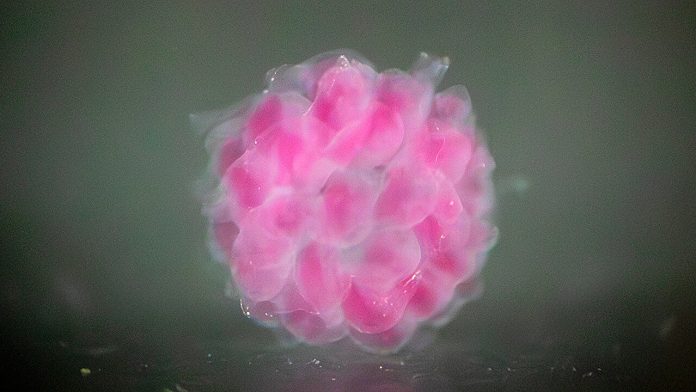
Imagine a future where human organs can be printed on demand.
A research team at the University of Virginia School of Engineering and Applied Science is working towards making this a reality.
They have developed a new technique that could be the foundation for creating human-compatible organs using 3D printing technology.
Liheng Cai, an assistant professor of materials science and engineering, along with his Ph.D. student Jinchang Zhu, has created biomaterials that mimic the mechanical properties of various human tissues.
These materials could be the building blocks needed for 3D-printed organs.
Their research, published in Nature Communications, introduces a unique bioprinting method called Digital Assembly of Spherical Particles (DASP).
This technique deposits tiny particles of biomaterial into a supporting matrix to build 3D structures.
These particles, called “voxels,” are the 3D equivalent of pixels and provide a suitable environment for cells to grow.
“Our new hydrogel particles are the first functional voxels we have ever made,” Zhu said. “With precise control over their mechanical properties, these voxels could be the basic building blocks for future 3D-printed organs.”
The hydrogels are designed to be both sturdy and cell-friendly. They are made from polymer hydrogels engineered to mimic human tissue by adjusting the arrangement and chemical bonds of single-molecule monomers.
These particles encapsulate actual human cells and are less toxic and more compatible with cells compared to other hydrogel bio-inks. Cai and Zhu’s hydrogels are formed from two intertwined molecular networks, making them strong yet highly adaptable to the physical characteristics of human tissue.
Cai and Zhu first introduced their DASP technology in 2021. Their initial work proved that biomaterial voxels could be used as building blocks, demonstrating a material that functioned like a pancreas by releasing insulin in response to glucose. However, the first version of DASP could only print brittle hydrogels with limited flexibility.
In their latest paper, Cai and Zhu present DASP 2.0, which uses “double-network” hydrogel bio-inks formed through a process called “click chemistry” to rapidly bond the molecular structures. This new method allows for more robust and tunable hydrogels.
Advancements in the team’s bioprinter also played a crucial role. They designed a multichannel nozzle to mix the hydrogel components on demand because the cross-linking process happens so quickly. This improved bioprinter can create large droplets that immediately form into an elastic, water-swollen gel within 60 seconds.
“Precise manipulation of these voxels is both a fundamental and technological challenge in soft matter science and 3D bioprinting,” Cai said. “We’ve now laid the foundation for voxelated bioprinting.”
The potential applications of this technology are vast, including artificial organ transplants, disease and tissue modeling, and drug screening. As this technology develops, it could revolutionize the medical field, making printed organs a common reality.
If you care about health, please read studies that vitamin D could help lower the risk of autoimmune diseases, and drug for inflammation may stop spread of cancer.
For more health information, please see recent studies about which drug can harm your liver most, and results showing this drug can give your immune system a double boost against cancer.



